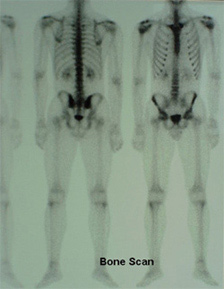Spine Tests: Bone Scan
What is a Bone Scan?
A bone scan is a useful diagnostic tool that spine surgeons sometimes use to detect areas of unusual activity in the bones. Bone scans are also known as nuclear imaging, because they capture pictures of the body using low-levels of radioactive elements.
Why We Use Bone Scans
Bone scans provide surgeons with a detailed assessment of areas of abnormal bone activity. This test can be important for diagnosing spinal problems such as:
- Tumor
- Infection
- Fracture
- Arthritis or inflammation
Bone scans are highly sensitive and can reveal abnormalities that are too small to appear on other tests such as x-rays, MRI's, or CT Scans.
How Bone Scans Work
 A bone scan involves an injection into the patient's arm. The injection then needs time to temporarily absorb into the bone. After a few hours, the injection has absorbed enough so that the scan can be performed.
A bone scan involves an injection into the patient's arm. The injection then needs time to temporarily absorb into the bone. After a few hours, the injection has absorbed enough so that the scan can be performed.
During the scan, you will lay on a table. A camera or scanner will then slowly scan your entire body. In the end, radiographs (x-ray-like pictures) will be produced that show an image of your entire bony structure. The doctor can then look at those pictures and determine the significance of any areas that are not normal. Areas of normal bone activity appear gray on the scan, while areas of increased activity, called "hot spots" appear darker.
What to Expect
The entire procedure will take several hours, although the bone scan itself will take only about an hour. You will get the injection and then be asked to wait for at least 2 hours, while the radioisotope temporarily absorbs into the bone.
Since the injection is often given in the morning, your physician may encourage you to go for breakfast afterwards, or perhaps run errands while you wait.
Your doctor will tell you the exact time you need to return to have the actual bone scan. The scanning portion of the bone scan usually lasts about one hour. You will be asked to remove jewelry and other metal objects, and you may be required to wear a hospital gown. You will be required to remain still during the scan, although you may be asked to move to various positions to assist with capturing the images.
Other than experiencing some possible discomfort from the injection, and from lying still for a prolonged period, there is no pain associated with this test.
Risks Associated with Bone Scan
The risks associated with a bone scan are minimal. Although some radiation exposure is experienced during this test, the amount of radiation is very small, and disappears from the body within 2-3 days. Reactions to the injection are very rare, but may include rash, swelling, or infection or bleeding at the injection site. In some rare instances, patients my experience difficulty breathing or chest pain related to the injection. Although these experiences are extremely rare, they can be life threatening. As with any test involving radiation, pregnant or nursing women should not undergo this examination. If there is any chance that you could be pregnant, it is important that you tell your doctor and/or the technician prior to getting the injection.
Conclusion
A bone scan can help to detect some spine abnormalities at an earlier stage than traditional x-rays, which can increase the likelihood of successful treatment. Therefore, it is an important diagnostic tool. Your physician will combine bone scan findings with other imaging studies and clinical information to provide the most accurate assessment of your spine health.
